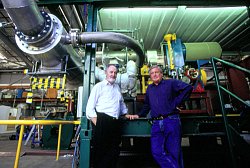
New technology for generating power from coal mining waste was launched by the Federal Minister for Industry, Tourism and Resources, the Hon. Ian Macfarlane, at CSIRO in Brisbane today.
The revolutionary technology has the potential to significantly reduce greenhouse gases and bring big savings to mining companies operating coal mines.
The CSIRO-Liquatech hybrid coal and gas turbine system unveiled at the Queensland Centre for Advanced Technologies will generate electricity from wa

Researchers at the University of Minnesota School of Public Health have found that aspirin use may decrease the incidence of pancreatic cancer, possibly through its anti-inflammatory effects. The study will be published in the Aug. 7 issue of the Journal of the National Cancer Institute.
For seven years, lead author Kristin Anderson, Ph.D., an assistant professor in the School of Public Health, and her colleagues followed a group of postmenopausal women from Iowa who were part of the Iowa

Study suggests promising new insights for men with early-stage disease
A fat-laden diet and high calcium consumption are both well-known suspected risk factors for prostate cancer. However, new findings from the Fred Hutchinson Cancer Research Center suggest that fat and calcium themselves may not cause prostate cancer, as previously thought, but instead may fuel its progression from localized to advanced disease.
While high intake of dietary fat and calcium is associated wi

Dartmouth Medical School geneticists have found a molecular shortcut from light reception to gene activation in their work to understand biological clocks. Their research has revealed that the protein called White Collar-1 does double duty: it perceives light and then, in response to light, directly turns on a key gene called frequency, which is a central component of the clock.
Biological clocks are molecularly driven and are set, or synchronized, by the daily cycles of light and dark. Usin

Cornell University potato breeders are donating a disease-resistant potato to Russia in an effort to help combat aggressive strains of potato late blight that are threatening to devastate the nation’s essential small farms.
The Cornell-developed New York 121 potato, which also is able to fend off golden nematodes, scab and potato virus Y (PVY), will be given to Dokagene Technologies, a company specializing in producing pathogen-free seed in Russia, in a meeting and a field trip in Mosc

The overuse of antibiotics not only leads to more resistant strains of infection, but, according to new research from the University of Wisconsin-Madison, antibiotics also may be adversely affecting zooplankton, tiny organisms that underpin the health of all freshwater ecosystems.
In the last decade, European and American researchers have found more evidence that lakes and streams are tainted by common drugs, ranging from caffeine to anticancer agents.
This pollution, says Colleen

Scientists at the University of Stuttgart have succeeded in controlling the structure and function of biological membranes with the help of “DNA origami”. The system they developed may facilitate the…

From the persistent droughts of southern Africa and Central America in the early part of the year to the more recent devastating extreme rainfall in Spain and the deadly Hurricane…

Researchers at the Max Planck Institute for Chemical Physics of Solids, in collaboration with Chongqing University and the Max Planck Institute of Microstructure Physics, have achieved a breakthrough in topological…

Importance of RNA modifications for the development of resistance in fungi raises hope for more effective treatment of fungal infections. An often-overlooked mechanism of gene regulation may be involved in…

HIRI researchers uncover control mechanisms of polysaccharide utilization in Bacteroides thetaiotaomicron. Researchers at the Helmholtz Institute for RNA-based Infection Research (HIRI) and the Julius-Maximilians-Universität (JMU) in Würzburg have identified a…

Most solids expand as temperatures increase and shrink as they cool. Some materials do the opposite, expanding in the cold. Lithium titanium phosphate is one such substance and could provide…

Long gone are the days where all our data could fit on a two-megabyte floppy disk. In today’s information-based society, the increasing volume of information being handled demands that we…

In the search for new materials that can enable more efficient electronics, scientists are exploring so-called 2-D materials. These are sheets of just one atom thick, that may have all…

How simulations help manufacturing of modern displays. Modern materials must be recyclable and sustainable. Consumer electronics is no exception, with organic light-emitting diodes (OLEDs) taking over modern televisions and portable…

Researchers from Osaka University introduced an innovative technology to lower power consumption for modern memory devices. Stepping up the Memory Game: Overcoming the Limitations of Traditional RAM Osaka, Japan –…

Cutting-Edge Framework for Enhancing System Security Researchers at the University of Electro-Communications have developed a groundbreaking framework for improving system security by analyzing business process logs. This framework focuses on…

AQSolotl’s quantum controller is designed to be adaptable, scalable and cost-efficient. Quantum technology jointly developed at Nanyang Technological University, Singapore (NTU Singapore) and National University of Singapore (NUS) has now…